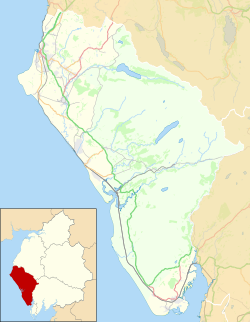| Blackbeck | |
|---|---|
| Village | |
 Reservoir above Blackbeck | |
Location within Cumbria | |
| OS grid reference | NY030068 |
| Civil parish | |
| Unitary authority | |
| Ceremonial county | |
| Region | |
| Country | England |
| Sovereign state | United Kingdom |
| Post town | EGREMONT |
| Postcode district | CA22 |
| Dialling code | 01946 |
| Police | Cumbria |
| Fire | Cumbria |
| Ambulance | North West |
| UK Parliament | |
Blackbeck is a small village in Cumbria, England. It is northeast of Beckermet and Sellafield, along the A595 road. [1] [2] It contains properties such as the Blackbeck Inn, Blackbeck Farm and Brow House. [3] [4]

